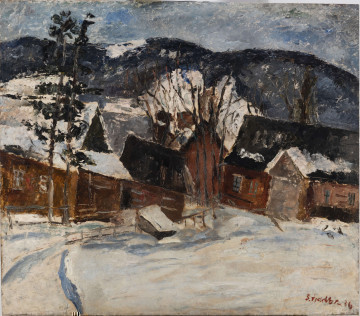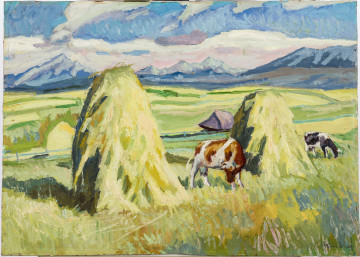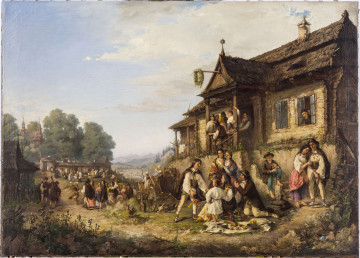
Winter landscape
1936
National Museum in Lublin
Part of the collection: Landscape
Stefan Filipkiewicz is one of the most outstanding representatives of the "Polish landscape school" of the Young Poland period and the 1920s-1930s.
Even before beginning his studies, he debuted with an exhibition presenting views of the Tatra Mountains. He developed his talent at the Kraków Academy under Józef Mehoffer, Józef Pankiewicz, Leon Wyczółkowski, and the most important, Jan Stanisławski. Among Stanisławski's disciples, Filipkiewicz developed the master's concepts most creatively. Landscape remained the dominant theme of his work, although he also painted still life and numerous flowers. He achieved the greatest artistic proficiency in depicting mountain landscapes, vast ranges, and his favourite Tatra peaks.
One of their examples is Pejzaż [Landscape] in Watercolour from 1922. It is an impressionistic record of a picturesque mountain panorama, captured on a cloudy, early spring day. The composition, dominated by tones of blue, green and yellow, depicts peaks drowning in clouds and mists, seen from a long distance. In the foreground, there is a sharp roof of a mountain cottage, blended into a gentle slope of a meadow. Behind a horizontal strip of grass, successive planes, arranged in a screen, intermingle with each other, stretch out. The masterly rendering of perspective depth draws the viewer's eye into the vast space, tense above the mountain massif with the sky illuminated by the silver glow of the sun. The harmony of colours, sometimes contrasted, harmonises with the order of the composition. Individual elements have been included in a calm rhythm of corresponding horizontal and diagonal lines. The combination of these means created an atmospheric vision conveying the essence of mountain nature.
It is worth recalling a few facts from Filipkiewicz's life. Between 1914 and 1917, the artist served in the Legions (he designed uniforms and legion shields). In 1939 he left with his family for Hungary, where he was active in the underground movement. He was the secretary of the Civic Committee for the Care of Polish Refugees, the representative of the Polish government in exile. The organisation saved about five thousand Jews by giving them new identities and organising false documents. Filipkiewicz was arrested in July 1944 by the Gestapo and murdered a month later in the Mauthausen-Gusen camp along with the Committee's president, Henryk Sławik, and his associates.
Bożena Kasperowicz
Author / creator
Dimensions
cały obiekt: height: 100 cm, width: 64 cm
Object type
image
Technique
aquarel
Material
paper
Creation time / dating
Creation / finding place
Owner
The National Museum in Lublin
Identification number
Location / status

1936
National Museum in Lublin

1901 — 1950
National Museum in Lublin

1870
National Museum in Lublin
DISCOVER this TOPIC
Museum of King Jan III's Palace at Wilanów
DISCOVER this PATH
Educational path